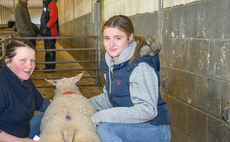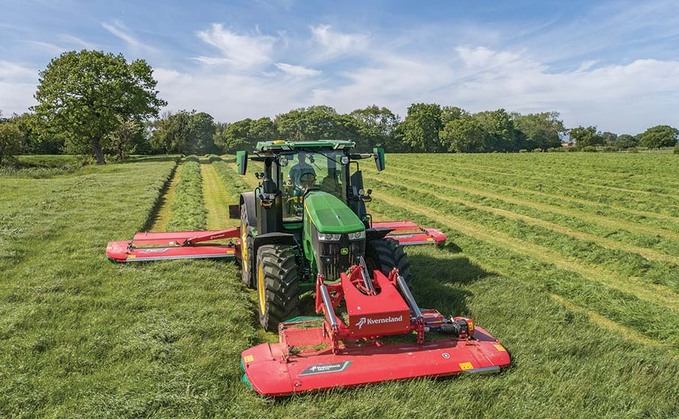
Representing more than just a facelift, we get under the skin of John Deeres latest generation 7R tractor series. James Rickard finds out more with a test drive.
Aside from a healthy dose of re-styling and a refreshed cab interior, you may be forgiven for thinking that John Deere has merely given its latest 7R a bit of an update.
However, while the cast iron bits and its overall dimensions remain pretty much unchanged, internally the latest generation 7R is a very different animal. And it all stems from Deeres ambition to right a few wrongs with the 7R.
As many will know, the 7R has not exactly been the manufacturers finest hour, particularly when it comes to reliability. And while the firms other tractor ranges have enjoyed a relatively healthy report card, Deere has had to put up with a perpetual blot against the 7R and its chequered history.
So what has Deere done to put things right? Fundamentally, the firm has gone right through the tractor from front to back and has changed and improved a multitude of components, especially in the transmission department. It has also managed to reduce hydraulic pipework by about 25 per cent.
While the new tractor is christened Gen 2, for us it seems more like the third version. Wind the clock back and the original 7R turned up on the scene in 2011, bringing with it the infamous push-type cooling package and electric power steering option. Transmissions at the time were limited to the firms CommandQuad robotised semi-powershift and its AutoPowr continuously variable transmission (CVT).
Fast forward to 2013, and a second iteration of the tractor was launched, dropping the push cooling in favour of a more conventional set-up. A transmission more befitting the tractor was also introduced, the e23 full powershift, and a refreshed control layout and terminal joined the party too.
To find out more about the latest tractor, we got our hands on a limited production build 7R 330, took it out of its arable comfort zone, and equipped it with a set of Kverneland triple mowers.
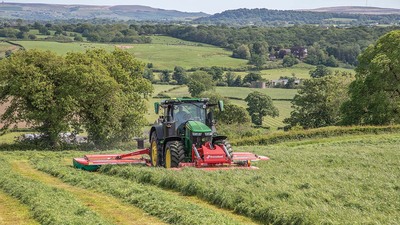
7R range overview
Rear-end
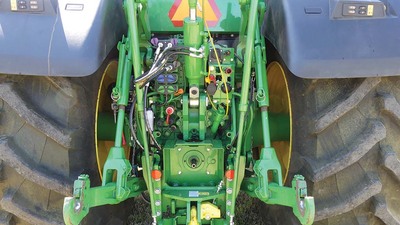
The 7R Series is now made up of six models, ranging from 250 to 350hp (rated power). As with many manufacturer's tractor ranges, the 7R has climbed up the power ladder over the years, dropping the smallest 230hp (rated) model along the way and gaining two new, more powerful models at the top-end of the series, the 7R 330 and 7R 350. The latter has a rated power of 350hp and a maximum rated power of 385hp (power bulge). Add to that the firm's intelligent power management and the tractor will be knocking on the door of 395hp.
With the new styling comes a new model numbering system, which sees the series number split up from the rated power figure. For example, what was once a 7310R, is now a 7R 310.
Rear-end layout is still the same as is linkage performance, with a near eight tonne lift capacity throughout the lift range (10.2 tonne maximum lift capacity), and a hydraulic pump output of up to 223 litres/minute.
Front-end is similar too, using the same ‘box' type cooling package and engines. Now meeting Stage 5 emissions, the four largest 7Rs use the same nine-litre engine as the larger 8R models, so have a lot to give. The two smallest models use the 6.8-litres, as used in the 6Ms and 6Rs.
Relating to the 7R's options and technology packages, three levels of spec can be chosen from; Premium, Ultimate and Signature.
Transmission
Transmission 1
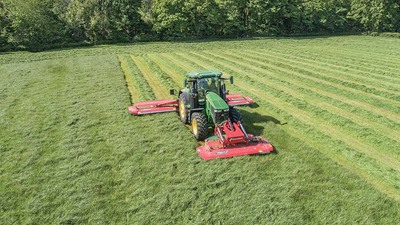
While the 7R comes with the same two transmission options as before, as mentioned both have been completely revised. This extends to new bearings, beefier components, improved lubrication and better management.
Our test 7R 330 model came with the AutoPowr CVT. While the CVT in the 6Rs is a ZF-based unit, the CVT in the 7R, and the 8R, is built in-house by Deere. The hydro-mechanical unit features four mechanical ranges and two hydro/pump units. Apart from a slight audible change between ranges, the ‘box gives a near seamless change of speed from zero to 50kph.
Cleverly, the cross-over point between each range is the most mechanically-efficient, enabling the engineers to ‘gear' this point to coincide with the most used speeds for fieldwork. I.e. the speeds at which the transmission is fully mechanical are 0, 10, 25 and 50kph. In all, the transmission never drops below 55 per cent mechanical efficiency.
There are no manual range changes to worry about either; the tractor does it all itself, depending on pedal or lever input. However, you can set two cruise speeds and you can limit the tractor's top speed. The latter is crucial when it comes to more accurate control of the tractor at slower speeds, especially around the yard when driving with the pedal.
The CVT also features a ‘power zero' function, whereby the tractor will ‘hold' itself on a hill without rolling.
Transmission 2
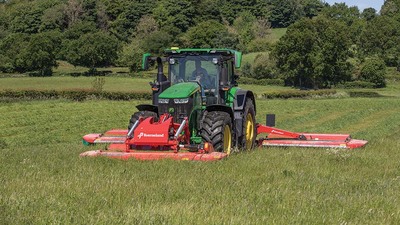
However, shuttling back and forth is one of its Achilles' heels. Unlike the 6R's CVT which features a pair of clutch packs for snappy direction changes, the 7R makes do with one. While this is a simpler, set-up, it does mean the tractor has to slow and come to a complete stop before changing direction, making shuttling a little more sedate.
Depending on your circumstances, this is something which you may not notice, but if you are doing a lot of shunting at headlands, it is something which can test your patience. If it is an issue, the e23 full powershift gearbox may be the better option, as works in a completely different way.
Thankfully, the 7R is a remarkably nimble tractor for its size. With its wheels fully set out to 2,082mm (82 inch), it can achieve a turning circle of 8.7m.
From a maintenance point of view, while there is a single filling point for the rear-end's oil, the transmission, trumpet housings and hydraulics all effectively have their own reservoirs. As a result, oil cannot mix between these reservoirs without first being filtered, reducing contamination.
Gears are also not sat in a bath of oil, but rather ‘pressure lubed' - effectively they are sprayed with oil, which dramatically reduces parasitic losses from not churning oil.
Cab
Cab 1
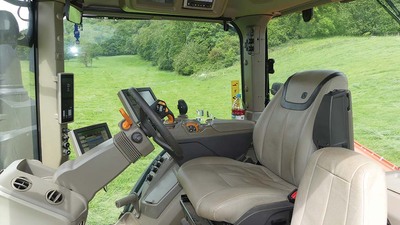
Visually, inside the cab is one area where you will find the most changes on the new tractor. While the cab frame itself is the same, steering wheel, steering column, ventilation placement and roof line have all been subjected to styling changes.
Practical changes include the removal of the old floor fridge and a new larger, 11 litre fridge located in the left rear corner of the cab. As well as offering a better cold compartment, this really opens up the floor space - enough to lose a family of four.
Giving it the full Easy Rider pose, foot pegs are included, enabling you to put your feet up. A third foot peg is also placed towards the right hand side of the cab, which when the seat is swivelled to the right, can be made the most of, offering a driving position ideal for keeping an eye on rear implements.
More seat swivel offers 45 degrees of movement to the right and 20 degrees to the left. Cleverly, when swivelling to the left, to avoid the control armrest hitting the steering wheel, the firm has engineered the armrest to swing out wide past the steering wheel. A small but very smart touch.
A change in air-con unit position has also brought some big changes. By taking it out of the roof and putting it underneath the cab at the back, it means headroom is much better, cab is quieter, and it gets to temperature quicker. Though, some space has been lost in the lower, rear portion of the cab.
Cab 2
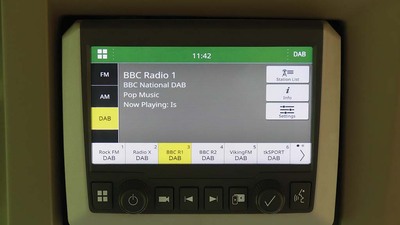
A new 6.5 inch touchscreen now adorns the roof line, which takes care of all infotainment functions. It can be paired with your phone and is compatible with Apple CarPlay and Android equivelent, giving access to your contacts, maps, music, etc. It does not take care of any tractor functions, for this, you still use the dedicated 10.4 inch touchscreen 4600 terminal and/or an optional ‘Extended Monitor' screen, as was fitted to our test machine. However, it does run the utterly amazing 6.1 surround sound system with subwoofer.
And then there is the seat. With Ultimate and Signature spec you get a full leather armchair with heating and cooling functions, a multitude of electric adjustment and a two-stage massage feature. The latter is the icing on the cake, but can take you by surprise when trying to mow around telegraph poles.
For comfort, the front axle suspension remains unchanged, but the hydraulic cab suspension has been ousted in favour of a simpler, four-point mechanical set-up which works just as good, if not better than the old system. But, crucially it means a lot less hydraulic pipework is needed underneath the cab, which massively contributes to the 25 per cent reduction in pipework, making routing and layout far neater.
Controls
Controls 1

Controls on the new 7R remain largely unchanged. The firm's CommandArm will be familiar to JD users, and is very easy to work out for non-JD users. Just as easy to fathom is the 10.4 inch, 4600 touch screen terminal, featuring clear icons and easy navigation.
New to the 7R is the availability of the CommandPro joystick option. Originally launched on the 6230R and 6250R tractor models in 2016, it brings with it much greater functionality. While to some its menagerie of buttons may seem over facing, it is actually very easy to use and set-up.
Most buttons on the ‘stick can be customised to how you like and/or the particular job at hand, and with buttons on both the near and far side of the ‘stick, it means you can make the most of your fingers and avoid putting all of the workload on your thumb, like many other joysticks.
In terms of feel, there is also a really good distinction between all the buttons, which avoids guessing or confusion.
As opposed to proportional control over a CVT, as you get with the firm's foragers and combines, CommandPro is a return-to-centre-style operation. As such, in terms of speed control, there are multiple ways of using the stick.
Once moving you can nudge the stick to alter speed, push and hold for a greater increase in speed, or push it right forward through a ‘gate' which takes you straight to top speed. Top speed can be quickly adjusted by a scroll wheel on the side of the stick, as can the two cruise speeds.
Controls 2
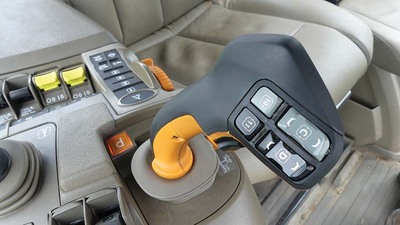
Transmission ‘aggression', can also be adjusted by an integrated button to one of three modes. In the least aggressive mode, each nudge of the stick will increase speed by 0.25kph; mode two 0.5kph and mode three 1kph. This adjustment also has an impact on the shuttling characteristics.
Shuttling can be done by holding a ‘consent' button and nudging the ‘stick to the left, or by a left hand lever on the steering column, while a nudge to the right will activate one of the cruise speeds. Sounding familiar?
An inching function is also in the ‘stick's repertoire. By pulling it fully to the left and moving back or forth, the tractor will move at very slow speeds, ideal for hooking up to implements. Just as well it has this as the feel of the throttle/travel pedal is awful, with very little feedback as to what it is doing.
On the plus side, there is no messing when switching between pedal or stick control; the tractor just simply recognises which one you are using.
Overall, driving the new 7R was a good reminder of just how good CommandPro is - it is an industry benchmark. But it should be, seeing as Deere by its own admission was ‘inspired' by multiple manufacturer's designs, in particular, a lot of the functionality is very similar to Fendt.
It is a shame, however, CommandPro is not available with the e23 transmission, as its functionality would work well with the full powershift transmission.
Practicalities and styling
Styling
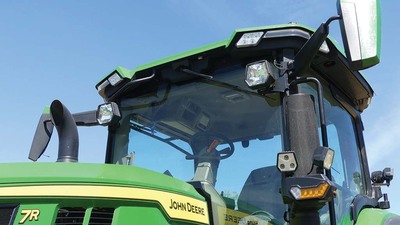
Courtesy of BMW California, externally, the lion's share of the new styling can be found on and around the cab, particularly its new angular looking lighting. With the ‘Ultimate Visibility' package, up to 22 LED lights can be specified. Strategically-placed strips of LED lights are also included, which light up key areas of the tractor, such as the steps.
Access
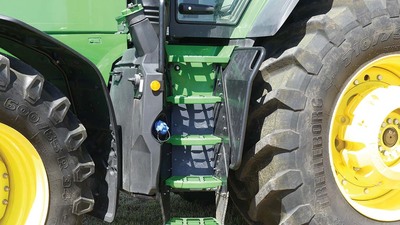
All access panels remain the same. However, access to the cab has seen a dramatic improvement, with larger steps and a straighter, easier route up to the cab, no matter which tyre size you choose. The cab's door handle is also placed at the bottom of the door, enabling you to get hold of it from ground level.
Right hand steps
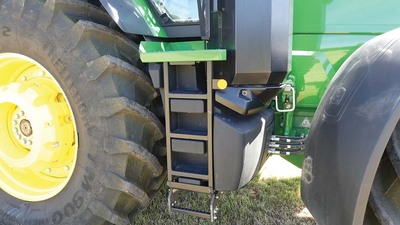
On the right hand side, a re-sculpted diesel tank with integrated steps offers a better platform for carrying out maintenance. However, the re-shuffling of the diesel tank means the firm has not been able to create an area for a large toolbox, like on the 6230R and 6250R models.
StarFire receiver
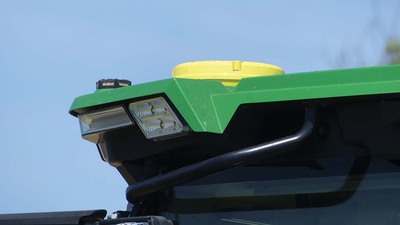
Up-top, a new integrated StarFire receiver is positioned at the front, right hand corner of the cab. While this does make it much more theft proof, it does mean the receiver is non-transferrable between tractors. For this, the current StarFire 6000 receiver can be specified.
LED beacons
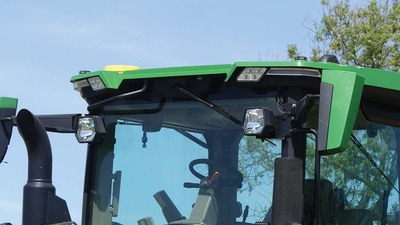
Similar to the StarFire receiver, small LED beacons are also integrated into the roof, with two at the front and one at the rear. Despite their diminutive stature, they are very bright.
Retaining clips
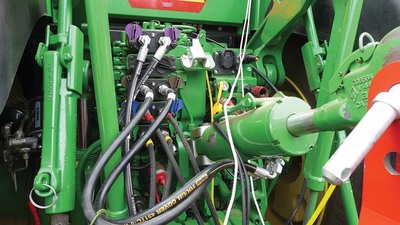
Unfortunately, Deere has kept the use of rubbish bits of coiled wire to retain things such as the top link. Considering the price of the tractor, you would think the firm could throw in a few R clips or linch pins.
Acknowledgements
- John Deere and the Cornthwaite Group for tractor and support, particularly Geoff Whiteside
- Kverneland and Clarke and Pullman for the mowers (more on these in a following report)
Verdict
Overall, it is clear to see that John Deere has been busy with the latest 7R, from the new features which you can see, to the improvement of the internal workings which you cannot see. While we can easily try out the former, we will have to see if the later has made the desired impact on reliability.
Of the bits we can try, the overhauled cab is a fantastic place to work, with comfort a stand out element. CommandPro is also a welcome addition and adds a lot to the 7Rs functionality.
However, for a 300,000-plus tractor, the firm really needs to sort out some quality retaining clips.
Overall, it is clear to see that John Deere has been busy with the latest 7R, from the new features which you can see, to the improvement of the internal workings which you cannot see. While we can easily try out the former, we will have to see if the later has made the desired impact on reliability.
Of the bits we can try, the overhauled cab is a fantastic place to work, with comfort a stand out element. CommandPro is also a welcome addition and adds a lot to the 7Rs functionality.
However, for a 300,000-plus tractor, the firm really needs to sort out some quality retaining clips.
























